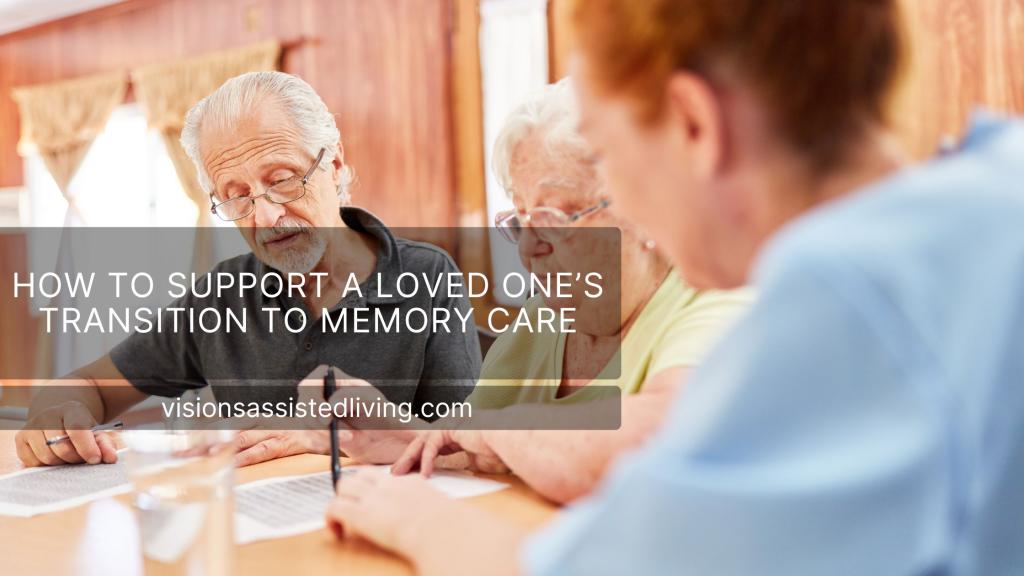How to Support a Loved One’s Transition to Memory Care
Helping a loved one make the transition to memory care can be one of the most emotional and challenging decisions a family faces. At Visions Assisted Living, we understand how important it is to honor your loved one’s dignity while ensuring their safety, health, and overall well-being during this life change.
Whether your loved one has Alzheimer’s, dementia, or another memory-related condition, the transition to memory care is a deeply personal journey. With the right mindset, planning, and support, this process can be less overwhelming—for everyone involved.
Understanding the Need for Memory Care
The decision to move a loved one into memory care often comes after months (or years) of gradual cognitive decline. Caregivers may begin to notice signs such as:
- Increased confusion or disorientation
- Wandering or getting lost
- Difficulty managing daily routines
- Changes in mood or behavior
- Missed medications or safety concerns at home
When these signs become frequent, it may be time to consider a secure and structured environment specifically designed for those with memory impairments. Memory care communities like Visions Assisted Living offer 24/7 supervision, enriching activities, and specially trained staff who understand the unique needs of individuals with dementia.
Step 1: Have the Conversation Early
One of the most important ways to support a smooth transition to memory care is to have open and honest conversations early on. If your loved one is still in the early stages of memory loss, involve them in the discussion and decision-making as much as possible.
Here are a few tips to guide the conversation:
- Choose a quiet, calm setting
- Focus on safety and quality of life, not limitations
- Be compassionate, not confrontational
- Use personal stories or examples from others when appropriate
- Allow time for the information to sink in
Early conversations reduce feelings of shock or betrayal when the time to move actually arrives. The more input your loved one can provide, the more empowered they’ll feel.
Step 2: Tour Memory Care Communities Together
Once you’ve decided to explore memory care options, visiting communities is the next step. This allows both you and your loved one to get a feel for the environment, meet staff members, and understand daily routines.
At Visions Assisted Living of Mesa, we invite families to schedule a tour, ask questions, and even participate in daily activities. This exposure helps ease anxieties and make the environment feel more familiar before the move.
Key features to look for in a memory care community include:
- Secured premises to prevent wandering
- Memory-enhancing activities and therapies
- Personalized care plans
- Comfortable and familiar layouts
- Social interaction opportunities
- Emergency response systems and on-site staff
👀 Internal Resource: Learn more about our memory care services and approach.
Step 3: Personalize Their New Space
Moving into a new living space can be disorienting, especially for someone experiencing memory loss. You can make the transition to memory care smoother by helping your loved one feel at home.
Bring familiar and meaningful items such as:
- Family photos or framed artwork
- Favorite bed linens or pillows
- A treasured armchair or quilt
- Religious items or mementos
- Books or music they enjoy
Avoid clutter and prioritize items that spark comfort, joy, or recognition. Many residents thrive in an environment that reflects their personality and memories.
Step 4: Prepare for the Emotional Side
Even with the best planning, emotions will run high. Your loved one may experience sadness, confusion, or resistance. As a caregiver, you might feel guilt or grief—even relief—which are all normal.
Here are ways to handle these emotional waves:
- Reassure your loved one that they are safe and cared for
- Let them express their fears without trying to fix them immediately
- Lean on support groups or online communities
- Stay involved with the care team and routines
- Take care of your own emotional health—don’t pour from an empty cup
💡 Pro Tip: The Alzheimer’s Association provides excellent emotional resources for both caregivers and families navigating this journey.
Step 5: Stay Connected After the Move
Once your loved one moves into a memory care facility, your role shifts from primary caregiver to supportive advocate. Maintaining regular visits, phone calls (if appropriate), and participation in events helps your loved one feel anchored and valued.
Consider:
- Attending meals or activities with them
- Bringing the grandchildren or pets for short visits
- Volunteering for events at the facility
- Sharing updates or pictures from home
The care team at Visions Assisted Living works with families to make visiting easy and meaningful, whether you’re local or out of town.
Why Choose Visions Assisted Living for Memory Care?
At Visions Assisted Living, we offer memory care in both Mesa and Apache Junction, Arizona. Our purposefully designed communities feature secure walking paths, life-enrichment programs, and compassionate, 24/7 care tailored to each resident’s needs.
We don’t just offer a place to live—we provide a safe, loving environment where your loved one can thrive.
Explore our Mesa location here, or learn more about our Apache Junction community.
Final Thoughts
The transition to memory care is never easy, but it doesn’t have to be painful. With empathy, education, and a trusted memory care partner like Visions Assisted Living, families can move forward with peace of mind and purpose.
Your loved one deserves a safe, joyful, and respectful life—and you deserve support in making that possible.
📞 Ready to Talk?
If you’re considering memory care for your loved one, we invite you to schedule a tour today and experience the compassion and care that sets Visions Assisted Living apart.
We’re here for you—every step of the way.



